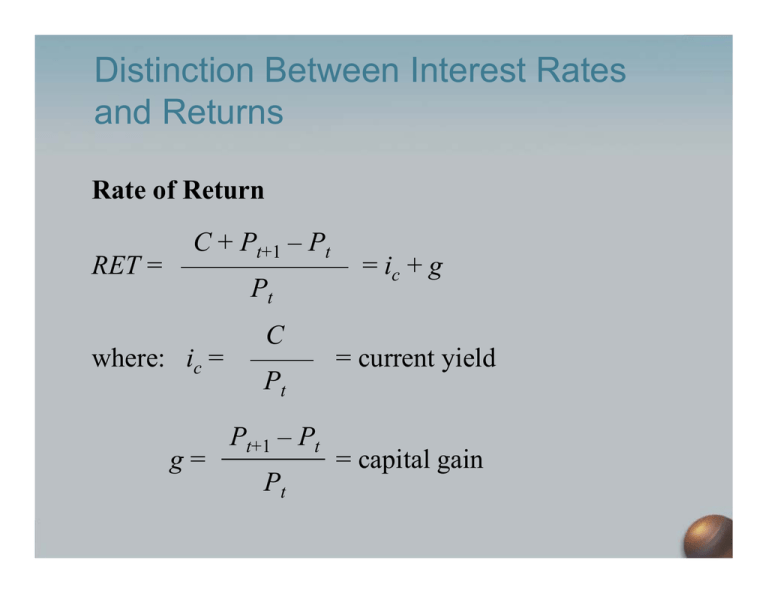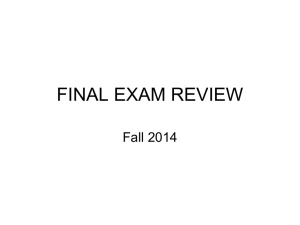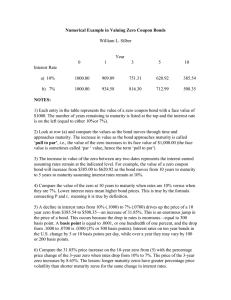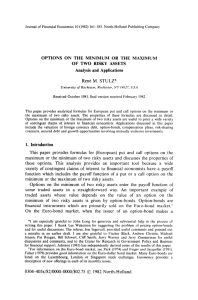
Distinction Between Interest Rates
and Returns
Rate of Return
RET =
C + Pt+1 – Pt
Pt
where: ic =
g=
C
Pt
Pt+1 – Pt
Pt
= ic + g
= current yield
= capital gain
Key Facts about Relationship
Between Interest Rates and Returns
© 2004 Pearson Addison-Wesley. All rights reserved
4-9
Maturity and the Volatility of Bond
Returns
• Only bond whose return = yield is one with
maturity = holding period
• For bonds with maturity > holding period, i ↑
P↓ implying capital loss
• Longer is maturity, greater is price change
associated with interest rate change
Maturity and the Volatility of Bond
Returns
• Longer is maturity, more return changes with change in
interest rate
• Bond with high initial interest rate can still have negative
return if i ↑
• Prices and returns more volatile for long-term bonds
because have higher interest-rate risk
• No interest-rate risk for any bond whose maturity equals
holding period
Distinction Between Real
and Nominal Interest Rates
Real Interest Rate
Interest rate that is adjusted for expected changes in the price level
ir = i – πe
1. Real interest rate more accurately reflects true cost of borrowing
2. When real rate is low, greater incentives to borrow and less to lend
if i = 5% and πe = 3% then:
ir = 5% – 3% = 2%
if i = 8% and πe = 10% then
ir = 8% – 10% = –2%
U.S. Real and Nominal Interest Rates
© 2004 Pearson Addison-Wesley. All rights reserved
4-12
Thinking about Uncertain Returns
¬ need to plan for different return scenarios
¬ think of returns being generated by a chance mechanism
¬ use historical series of returns to infer probabilities for future
returns
¬ the investment horizon matters a lot for what these
probabilities are
¬ potential problem: probabilities for tomorrow's returns might
depend on current return, or other variables (e.g. boom,
recession)
¬ actually, returns not well predictable over short periods of
time, but over long periods there is predictability
Risks to Bondholders (1)
One-Period Nominal Return for a bond with coupon payment C,
price P :
¬ if maturity is one period, then price is known, nominal return
can be foreseen (except perhaps if bankruptcy risk)
¬ if maturity is longer than one period, price fluctuations imply
that bond is a risky asset !
¬ long bond prices fluctuate if one-period interest rate changes
(higher short rate ¬! bond prices go down)
Risks to Bondholders (2)
¬ Real Return on a bond, with expected rate of inflation:
¬ `ex post' (with realized inflation), Fisher equation true by
definition
¬ `ex ante' (with expected inflation), it is hard to test, because
expected inflation is not observed
¬ but: many countries have indexed bonds, so real returns
become observable
¬ in countries with hi inflation risk, firms often borrow in foreign
currency
'
$
Probability Distributions
Suppose a random variable, such as a return R, can take N values,
R1 , R2 , ..., RN , with probabilities π1 , π2 , ..., πN , respectively.
We summarize its behavior by
• Mean E[R] =
N
n=1
πn Rn
• Measures of Risk
&
N
πn (Rn − E[R])2
– Standard Deviation σ(R) = var(R)
– Variance var(R) =
n=1
%
Risk Return Tradeoff
¬ mean-standard-deviation diagram shows risk and expected
return of possible portfolios
¬ every asset (or portfolio) can be represented by one point
¬ given a risky and a riskless asset, we can generate any portfolio
on a straight line through the two assets
¬ points between the two assets correspond to positive portfolio
weights.
Preferences determine the optimal mix of risky and riskless asset.
Several Risky Assets
Consider two stocks
State
1
2
Probability
.5
.5
Pepsi return RP
.15
-.15
Coke return RC
0
.2
E[RP ] = 0 E[RC ] = :1
p
C
Standard Deviations StD(R )= :5(:1)2 + :5(¬:1)2 ) = :1,
p
P
StD(R ) = :5(¬:15)2 + :5(:15)2 ) = :15
Expected Returns:
! Coke looks more attractive than Pepsi, but: combining the two
can give a riskless portfolio (pick w P = :4; wC = :6) !
Diversification
Bottom Line: by holding several risky assets, risk can be reduced
(diversification)
¬ expect to see people spreading wealth across many assets
¬ how `good' an asset looks depends not only on own risk and
return; for example, emerging markets are attractive because of
low correlation with US index,
¬ puzzle: not a lot of cross-border equity holdings







